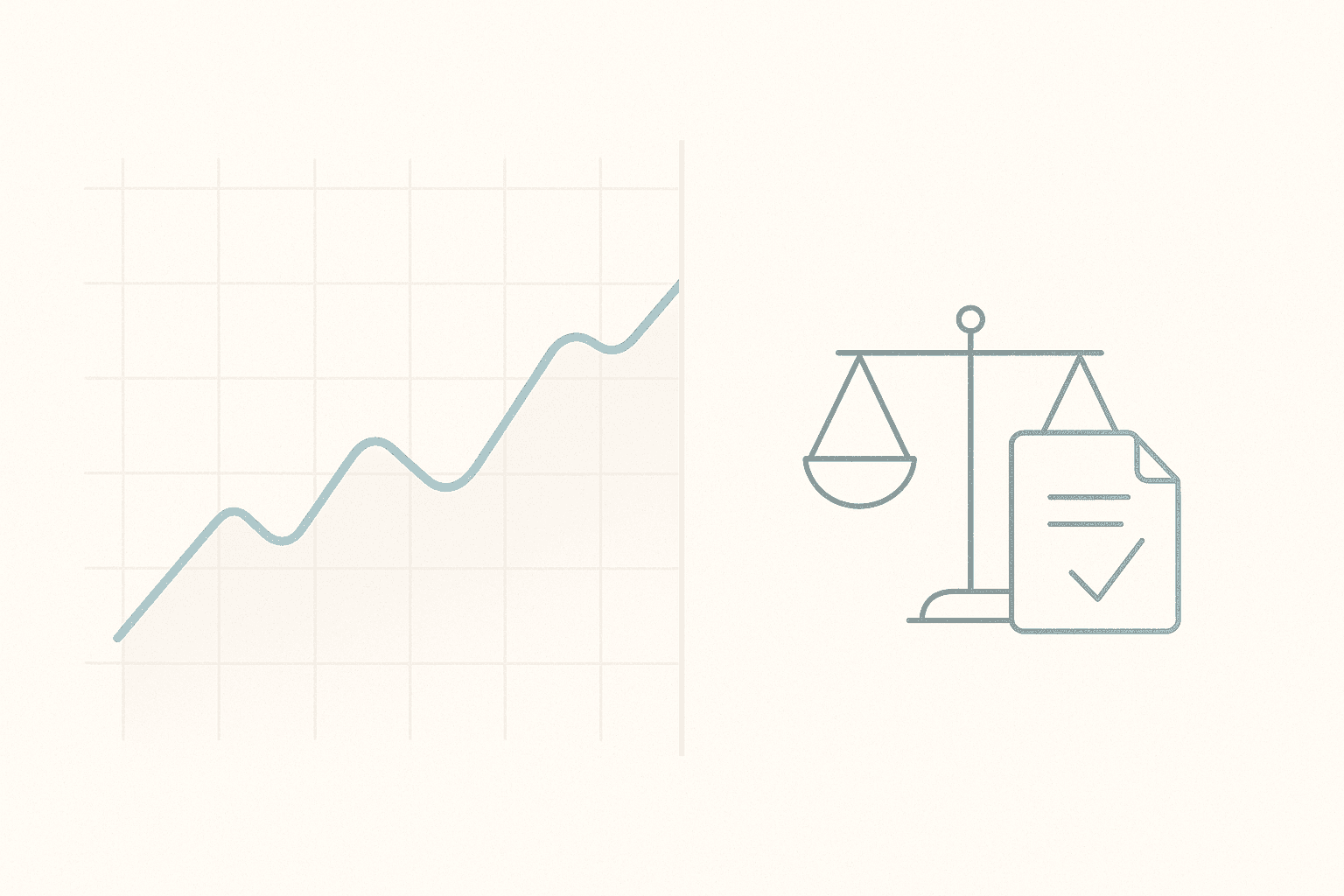AI Lawyer Blog
Credit Application Form Template (Free Download + AI Generator)

Greg Mitchell | Legal consultant at AI Lawyer
3
A Credit Application Form is a standardized document used by lenders, suppliers, or financial institutions to collect essential information from individuals or businesses seeking credit. It typically includes personal or business details, financial information, references, and consent for credit checks. This form serves as the foundation for assessing creditworthiness and determining the terms of credit extended.
According to the Federal Reserve's 2023 Small Business Credit Survey, 37% of small businesses applied for a loan or line of credit in 2023, highlighting the importance of a streamlined credit application process.
Download the free Credit Application Form Template or customize one with our AI Generator — then have a local attorney review before you sign.
This guide is part of our Financial Agreements series — guiding individuals and businesses through secure money management and lending practices.
You Might Also Like:
1. What Is a Credit Application Form
A Credit Application Form is a standardized document used by banks, finance companies, landlords, and vendors to collect data needed for a credit decision. The form provides a consistent way to capture identity, address history, income, liabilities, and permission to obtain a credit report.
For businesses, a version of this form may capture trade references, legal entity details, tax IDs, and financial statements. For consumers, it often includes consent language for consumer reports and verification. A complete and truthful application reduces follow-up requests, shortens decision time, and improves fairness across applicants.
2. Why a Credit Application Form Matters in 2025?
The credit landscape is dynamic, with lenders balancing risk and access to credit in real time. The New York Fed’s Survey of Consumer Expectations (SCE) Credit Access module reported that application and rejection rates were largely stable in June 2025, while rejection rates for certain loan types fell, underscoring the value of clean applications when conditions shift.
Outside the United States, credit usage remains widespread. The Bank of Canada notes that about 90% of Canadian adults had at least one credit card in 2019, highlighting how credit screening tools touch most households even as conditions evolve.
In the UK, the FCA’s Financial Lives Survey found that 16% of adults who checked their credit file identified an error or issue, reinforcing why consent, verification, and accurate data capture in applications are critical for fair outcomes.
3. Key Sections and Components
Applicant Identification: Full legal name, date of birth, government ID type and number, current and prior addresses.
Contact Details: Phone numbers, email, and preferred communication method.
Employment and Income: Employer name, position, length of employment, gross income, other income sources.
Housing Information: Own or rent, monthly payment, landlord or mortgage servicer contact.
Financial Accounts: Bank name, account types, average balances, existing credit facilities.
Debt Obligations: Credit cards, loans, leases, minimum payments, and outstanding balances.
References: Personal or trade references with contact details.
Consent and Disclosures: Authorization to obtain consumer or commercial credit reports, verification statements, and adverse action notices where required.
Certification and Signature: Applicant’s confirmation that information is true, with signature, date, and IP or device stamp for e-signatures.
For Business Applicants: Legal entity type, registration numbers, UBOs, financial statements, and trade terms acceptance.
4. Legal Requirements by Region
United States: Equal Credit Opportunity Act (ECOA) and Regulation B prohibit discrimination and require adverse action notices within set timelines. The Fair Credit Reporting Act (FCRA) governs consent and permissible purpose for pulling reports and requires proper identity matching and dispute handling. State privacy and e-signature laws may add requirements.
European Union: GDPR governs the processing of personal data; applicants must receive transparent disclosures regarding purpose, legal basis, retention, and rights. Automated decisioning may trigger additional safeguards and the right to human review.
United Kingdom: UK GDPR and the Equality Act apply; lenders must ensure fair treatment and provide appropriate notices. Credit reference agency data usage is subject to strict transparency and dispute resolution processes.
Canada: Federal and provincial privacy laws (PIPEDA and provincial analogs) require consent, limited collection, and access rights. Provincial consumer protection laws and human rights statutes regulate fairness in lending decisions.
Always confirm local rules and retain copies of the application and disclosures in accordance with record-keeping requirements.
5. How to Customize Your Credit Application Form?
Align fields to product risk: Higher-risk credit (e.g., unsecured revolving) may require more granular income and liability details than secured credit.
Add regional disclosures: Insert jurisdiction-specific privacy, consent, and adverse action language so decisions meet local law.
Support digital onboarding: Include explicit e-signature consent, device fingerprint or IP capture, and KYC/KYB checks.
For business credit: Add trade terms, personal guaranty clauses if applicable, and fields for ultimate beneficial owners when policy requires.
Accessibility and language: Provide plain-language explanations, multi-language options, and screen-reader compatible forms to reduce errors and increase fairness.
Fraud controls: Use validation rules, required fields, and document uploads (pay stubs, bank statements) for verification when thresholds are met.
6. Step-by-Step Guide to Completing and Reviewing It
Start by gathering accurate documents so you can complete the form without omissions.
Step 1 - Collect identification: Gather government ID, addresses for the past 24–60 months, and Social Security or national ID where permitted.
Step 2 - Document income: Assemble recent pay stubs, employment letters, tax returns, or bank statements; for businesses, prepare financials and tax IDs.
Step 3 - List liabilities: Compile credit cards, loans, leases, and monthly obligations so debt-to-income can be calculated correctly.
Step 4 - Complete all fields: Enter information exactly as shown on official documents to avoid mismatches during verification.
Step 5 - Read disclosures: Review consent, privacy, and adverse action language; ensure you understand what data will be accessed and how it will be used.
Step 6 - Upload evidence: Attach requested documents or connect financial data feeds if offered by the lender’s portal.
Step 7 - Review for accuracy: Check numbers, names, and dates; correct any inconsistencies before submission.
Step 8 - Sign and submit: Provide a wet signature or e-signature; save a copy of the completed form and confirmation page.
Step 9 - Respond to requests: If the lender asks for clarifications, answer quickly to keep the file moving.
Step 10 - Track decision and next steps: Note dates and any conditions of approval; keep the adverse action notice if declined for future reference.
7. Tips for Accuracy and Compliance
Use precise income figures: Round only if permitted; mismatches cause delays or denials.
Disclose all obligations: Hidden debts surface in the credit pull and may undermine credibility.
Keep contact data current: Missed verification calls or emails slow decisions.
Separate applicant vs. co-applicant fields: Avoid mixing data between parties.
Attach readable documents: Blurry photos lead to re-requests; use PDFs where possible.
Respect privacy: Only collect data required for the decision; excessive data increases compliance risk.
Maintain audit trails: Time stamps, consent logs, and version history support regulatory reviews.
8. Checklist Before Submission
Identity and address history completed and consistent with documents.
Employment and income verified with current evidence.
All debts and obligations listed accurately.
Consent and disclosures read and accepted.
Supporting documents attached and legible.
Signatures provided; a copy saved for your records.
Download the Full Checklist Here
9. Common Mistakes to Avoid
Estimating income loosely instead of using documented figures.
Omitting previous addresses that appear on credit reports.
Forgetting to list co-signed debts that affect capacity.
Leaving fields blank or using “N/A” where a number is required.
Ignoring privacy and consent language that affects rights to dispute data.
Submitting photos of documents that are cropped or unreadable.
10. FAQs
Q: Does completing a Credit Application Form affect my credit score?
A: Submitting an application usually authorizes a “hard inquiry” on your credit file, which may have a small, temporary impact on your score. The effect is typically modest and diminishes over time. Multiple inquiries for the same product type within a short window may be treated as a single event by some scoring models. Always read the consent language so you know what kind of inquiry will occur and how your data will be used.
Q: What documents should I prepare before applying for credit?
A: For consumer credit, gather a government ID, recent pay stubs or bank statements, and proof of address. For self-employed applicants, tax returns and business financials help. Business applicants should add entity registration documents, trade references, and financial statements. Having these items ready reduces back-and-forth and speeds underwriting decisions significantly.
Q: How long will a decision take once I submit the form?
A: Timelines vary by lender and product. Automated systems can return decisions quickly, but manual reviews may take days if documentation needs verification. Delays often result from missing documents, inconsistent data, or difficulty contacting references or employers. Submitting a complete, accurate form and responding swiftly to follow-ups helps shorten the timeline.
Q: What happens if there is an error in my credit report?
A: In many jurisdictions, you have the right to dispute inaccuracies with the credit bureau and the furnisher of information. In the UK’s Financial Lives Survey, 16% of adults who checked their file found an error or issue, which shows how important it is to verify data. Keep records of your disputes and provide supporting documents so corrections can be made promptly.
Q: Why does a lender ask for permission to pull my credit report?
A: Laws like the FCRA in the U.S. and similar regimes elsewhere require a permissible purpose and often explicit consent to access your credit data. The application’s consent section documents that permission and explains how your data will be used, stored, and shared. Without that consent, lenders typically cannot legally obtain your credit report or score for underwriting.
Sources and References
Credit access and application statistics are based on the U.S. Small Business Administration (SBA), which found that 37% of small businesses applied for loans or lines of credit in 2023.
U.S. consumer credit data and compliance rules are drawn from the Equal Credit Opportunity Act (ECOA, 15 U.S.C. §1691 et seq.), Regulation B (12 CFR §1002), and the Fair Credit Reporting Act (FCRA, 15 U.S.C. §1681 et seq.), overseen by the Consumer Financial Protection Bureau (CFPB).
International privacy and fairness standards reference the EU General Data Protection Regulation (GDPR, Regulation (EU) 2016/679), the UK GDPR and Equality Act 2010, and Canada’s Personal Information Protection and Electronic Documents Act (PIPEDA).
Additional market insights draw from the Board of Governors of the Federal Reserve System and the UK Financial Conduct Authority (FCA) Financial Lives Survey.
These resources reflect 2025 best practices for structuring compliant, fair, and data-secure credit application processes.
Disclaimer
This article is for informational purposes only and does not constitute legal, financial, or compliance advice. Laws and regulations vary by jurisdiction and change over time. Always consult a licensed attorney or compliance professional in your area before preparing or relying on a Credit Application Form.
Get Started Today!
A clear Credit Application Form streamlines decisions, protects privacy, and supports fair lending across markets. Use it to capture accurate data, provide proper consent, and reduce processing delays.
Download the freeCredit Application Form Template or customize one with our AI Generator — then have a local attorney review before you sign.
Explore more resources in our Financial Agreements series to secure your money management and lending practices.
You Might Also Like:



